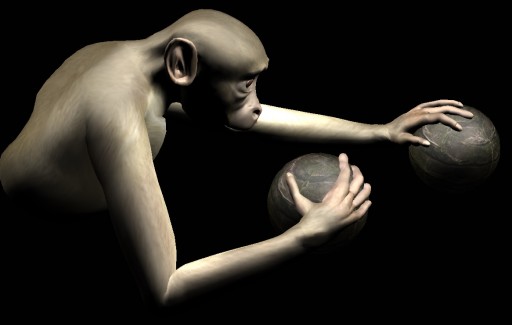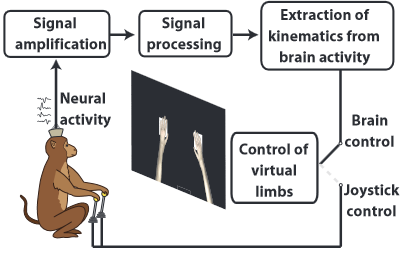Monkeys move two virtual arms with their minds
November 8, 2013
[+]
In a study led by Duke researchers, monkeys have learned to control
the movement of both arms on an avatar using just their brain activity.
Large-scale
brain activity from a rhesus monkey was decoded and used to
simultaneously control reaching movements of both arms of a virtual
monkey avatar towards spherical objects in virtual reality (credit: Duke
Center for Neuroengineering)
The findings advance efforts to develop bilateral movement in brain-controlled prosthetic devices for severely paralyzed patients.
To enable the monkeys to control two virtual arms, researchers recorded nearly 500 neurons from multiple areas in both cerebral hemispheres of the animals’ brains, the largest number of neurons recorded and reported to date
Millions of people worldwide suffer from sensory and motor deficits caused by spinal cord injuries. Researchers are working to develop tools to help restore their mobility and sense of touch by connecting their brains with assistive devices. The brain-machine interface approach, pioneered at the Duke University Center for Neuroengineering in the early 2000s, holds promise for reaching this goal. However, until now, brain-machine interfaces could only control a single prosthetic limb.
Bimanual movements
“Bimanual movements in our daily activities — from typing on a keyboard to opening a can — are critically important,” said senior author Miguel Nicolelis, M.D., Ph.D., professor of neurobiology at Duke University School of Medicine. “Future brain-machine interfaces aimed at restoring mobility in humans will have to incorporate multiple limbs to greatly benefit severely paralyzed patients.”
Nicolelis and his colleagues studied large-scale cortical recordings to see if they could provide sufficient signals to brain-machine interfaces to accurately control bimanual movements.
[+]
The monkeys were trained in a virtual environment within which they
viewed realistic avatar arms on a screen and were encouraged to place
their virtual hands on specific targets in a bimanual motor task.
The
monkey is seated in front of a screen showing two virtual arms and uses
either joystick movements or modulations in neural activity to control
the avatar arms.(credit: Duke Center for Neuroengineering)
The monkeys first learned to control the avatar arms using a pair of joysticks, but were able to learn to use just their brain activity to move both avatar arms without moving their own arms.
As the animals’ performance in controlling both virtual arms improved over time, the researchers observed widespread plasticity in cortical areas of their brains.
These results suggest that the monkeys’ brains may incorporate the avatar arms into their internal image of their bodies — a finding recently reported by the same researchers in the journal Proceedings of the National Academy of Sciences.
The researchers also found that cortical regions showed specific patterns of neuronal electrical activity during bimanual movements that differed from the neuronal activity produced for moving each arm separately.
The study suggests that very large neuronal ensembles — not single neurons — define the underlying physiological unit of normal motor functions. Small neuronal samples of the cortex may be insufficient to control complex motor behaviors using a brain-machine interface.
“When we looked at the properties of individual neurons, or of whole populations of cortical cells, we noticed that simply summing up the neuronal activity correlated to movements of the right and left arms did not allow us to predict what the same individual neurons or neuronal populations would do when both arms were engaged together in a bimanual task,” Nicolelis said. “This finding points to an emergent brain property — a non-linear summation — for when both hands are engaged at once.”
A brain-controlled neuroprosthetic device for humans
Nicolelis is incorporating the study’s findings into the Walk Again Project, an international collaboration working to build a brain-controlled neuroprosthetic device. The Walk Again Project plans to demonstrate its first brain-controlled exoskeleton, which is currently being developed, during the opening ceremony of the 2014 FIFA World Cup.
In additional to Nicolelis, other study authors include Peter J. Ifft of the Department of Biomedical Engineering and the Center for Neuroengineering at Duke University; Solaiman Shokur of the Center for Neuroengineering at Duke University and Ecole Polytechnique Fédérale de Lausanne in Switzerland; and Zheng Li and Mikhail A. Lebedev of the Center for Neuroengineering and Department of Neurobiology at Duke University School of Medicine.
The research was supported by the National Institutes Health (DP1MH099903 and R01NS073952).
Abstract of Science Translational Medicine paper
Brain-machine interfaces (BMIs) are artificial systems that aim to restore sensation and movement to paralyzed patients. So far, BMIs have enabled only one arm to be moved at a time. Control of bimanual arm movements remains a major challenge. We have developed and tested a bimanual BMI that enables rhesus monkeys to control two avatar arms simultaneously. The bimanual BMI was based on the extracellular activity of 374 to 497 neurons recorded from several frontal and parietal cortical areas of both cerebral hemispheres. Cortical activity was transformed into movements of the two arms with a decoding algorithm called a fifth-order unscented Kalman filter (UKF). The UKF was trained either during a manual task performed with two joysticks or by having the monkeys passively observe the movements of avatar arms. Most cortical neurons changed their modulation patterns when both arms were engaged simultaneously. Representing the two arms jointly in a single UKF decoder resulted in improved decoding performance compared with using separate decoders for each arm. As the animals’ performance in bimanual BMI control improved over time, we observed widespread plasticity in frontal and parietal cortical areas. Neuronal representation of the avatar and reach targets was enhanced with learning, whereas pairwise correlations between neurons initially increased and then decreased. These results suggest that cortical networks may assimilate the two avatar arms through BMI control. These findings should help in the design of more sophisticated BMIs capable of enabling bimanual motor control in human patients.
(¯`*• Global Source and/or more resources at http://goo.gl/zvSV7 │ www.Future-Observatory.blogspot.com and on LinkeIn Group's "Becoming Aware of the Futures" at http://goo.gl/8qKBbK │ @SciCzar │ Point of Contact: www.linkedin.com/in/AndresAgostini
 Washington
Washington